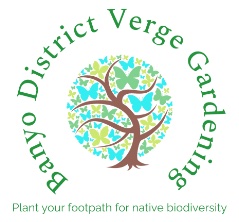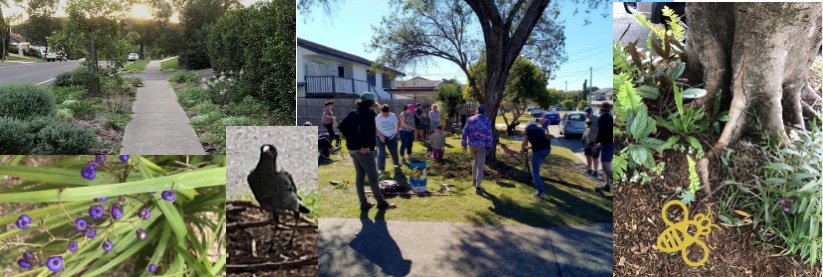A key participant in this pilot project is Nundah Community Enterprises Co-operative (NCEC). When we started, we had no idea how long it would take to do a verge conversion so it was hard to know how much to include in the grant application. Nobody is offering verge conversions as a commercial service. The only way was to include a number of person-hours and experiment within that.
When I saw this verge, I knew it was the ideal site for the first verge conversion by NCEC.
Key elements were:
- It was a large flat verge with two street trees.
- It was at the dead end of a street so there were no issues with passing traffic and noise.
- It was opposite a walkway between houses so pedestrians would approach the verge garden as they came through. That means plenty of exposure to see how people reacted.
- The residents were supportive of the experimental nature of what we were doing, and agreed to take on long-term responsibility for the verge garden.
- There were already good connections and communication between the surrounding neighbours.

The verge is an unusual worksite. It’s public land and cars can be parked or driving close by. Because verge gardens must be associated with the resident in the adjoining house, there was access to water.

They took out some soil at the edge of the verge so mulch is flush with the kerb. This avoids any mulch being washed into stormwater in heavy rain. Some of the tubestock plants put in a few weeks ago have already started to grow. Planting as you go helps everyone feel the progress and imagine the end result.

Almost finished. The space feels very different to the plain grass rectangle we started with. There are gaps in planting at intervals to allow access to and from the road. If there is no concrete footpath, you need to leave a grass pathway for pedestrians – but it’s still much less grass to mow.

Finished, with more tubestock planted. There are many advantages to using small plants and they’ll establish well. Come to one of our workshops, or see this free course to find out more.
It will be an inviting path to walk along and look at the plants, but for some time it will be a path to nowhere.
That’s one of the lessons of verge gardening – your surroundings will change and you have to consider future users of the space as well as current ones. One day, this will probably be the pathway for people walking to a new housing development.
So, what were the outcomes of this activity?
- Work for the Youth Co-op team at Nundah Community Enterprises Co-operative on this verge and opening up opportunities for work on more verges and with more projects
- Many conversations to develop the network and relationships between people and organisations who will continue to collaborate when this pilot project has finished
- An example of a verge for all local residents to see the style of planting and the native plants suited to this space
- A better understanding for all involved about this collaborative model, working within the council policy, to ensure ongoing sustainability and achieve the scale we need to increase shade and biodiversity throughout our suburbs
- An example of how, when we work together in this way, environmental and social and economic outcomes can be achieved within one activity or project
That makes this a pathway for a brighter future.

